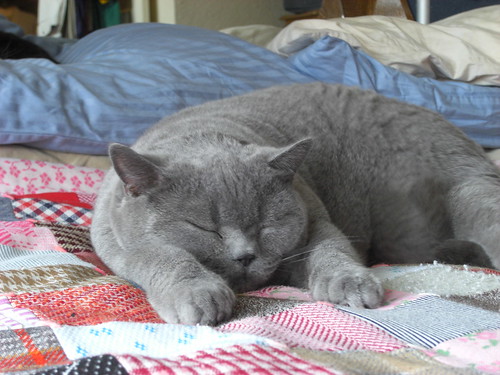The British Shorthair is a domesticated cat. Its features make it a popular breed in cat shows. It has been the most popular breed of cat registered by the UK's Governing Council of the Cat Fancy (GCCF) since 1999 when it overtook the Siamese breed.
The British Shorthair is the descendant of cats brought to Britain by the Romans, which were interbred with wild native cats. Later they were crossbred with Persian cats to improve the thickness of their coat. The breed was defined in the 19th century and British Shorthairs were shown at the 1871 Crystal Palace cat show. The popularity of the breed had declined by the 1940s, but since the end of the Second World War, breeding programs have intensified and the breed's popularity is high once again. The first British Shorthairs arrived in Australia in 1968. Breeding under the prefix Redwyton, Tops and Trevor Jowett imported a blue breeding pair.
The British Shorthair is the descendant of cats brought to Britain by the Romans, which were interbred with wild native cats. Later they were crossbred with Persian cats to improve the thickness of their coat. The breed was defined in the 19th century and British Shorthairs were shown at the 1871 Crystal Palace cat show. The popularity of the breed had declined by the 1940s, but since the end of the Second World War, breeding programs have intensified and the breed's popularity is high once again. The first British Shorthairs arrived in Australia in 1968. Breeding under the prefix Redwyton, Tops and Trevor Jowett imported a blue breeding pair.
British Shorthairs have dense, plush coats that are often described as crisp or cracking, which refers to the way the coat breaks over the cat's body contours. Eyes are large, round and widely set. They can be a variety of colours, though the copper or gold eyes of the British blue are the best known. They have round heads with full, chubby cheeks and a body that is rounded and sturdy. British Shorthairs are large and muscular, and are described as having a cobby build. The breed has a broad chest, shoulders and hips with short legs, round paws and a plush but not fluffy tail. These are the characteristics listed in most governing bodies breeds standards to which show cats must conform.
The males of this breed are larger than the females, and the size difference between them is more easily noticed compared to other breeds. The males' average weight is 5-10 kilograms, whereas a female would weigh up to 5-7. As with many breeds, the adult males may also develop prominent cheek jowls that distinguish them from their female counterparts. The typical lifespan of this breed is 14 to 20 years.
The males of this breed are larger than the females, and the size difference between them is more easily noticed compared to other breeds. The males' average weight is 5-10 kilograms, whereas a female would weigh up to 5-7. As with many breeds, the adult males may also develop prominent cheek jowls that distinguish them from their female counterparts. The typical lifespan of this breed is 14 to 20 years.





No comments:
Post a Comment